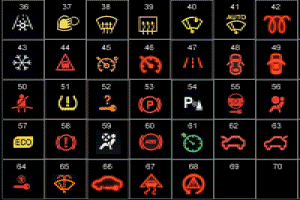What They Don't Teach In Driving School (but probably should)

Driving school is a rite of passage for anyone who wants to get behind the wheel. Driving schools typically do a great job of teaching students all about the rules of the road, safe driving techniques and the fine art of parallel parking. However, they don't teach the two things you need to know to stay on the road: 1) Listening to your car, and 2) Maintaining your car. Not paying attention to a car's warning signals and maintenance needs can result in a broken-down vehicle, an accident, or hefty repair bills.
Listening to Your Car
Today's vehicles have been designed to make you aware of maintenance and repair needs. If you don't read any other section of your owners manual, it pays to become familiar with the signals and warnings your car has, and understand what the symbols represent. If a light comes on and you're not sure what it is, the safest thing to do is pull over and check the owners manual.

In general, less expensive and older cars have fewer and more generic warnings, and more expensive, newer and foreign cars have more detailed warnings. Some manufacturers, such as BMW, color code their lights. Red lights signal severe issues, like the car overheating, while Orange lights are for less urgent needs, like the need for an oil change. Always stop the car if you see severe issue lights, such as brakes, charging system, and engine coolant temperature. It is better to pay for a $75 tow than thousands of dollars for collision repairs or a new engine.
In addition to the lights on the dashboard, you also need to be aware of the sounds your vehicle makes and how it handles. Familiarize yourself with the normal sounds your car makes, so you recognize when things are different. Turn off the music, find an empty, quiet road and really listen to your car. Listen when you run at a steady speed, accelerate and decelerate. Do you hear a normal hum? Or do you hear ticking, squeeking, grinding or squealing? If possible, try to identify the general location of the noise. Unusual noises should be assessed by a professional.
Then pay attention to how it handles. The car should drive smoothly, without any hesitations or rough shifting. Does it drive straight down the road, or does it pull to one side? Brake at lower and higher speeds, see if the car stops easily, and take note of any vibrations, noises or pulling. If you notice any issues, make sure you have qualified technician take a look.
All too often, people experiencing car problems try to make it to their destination and wind up regretting it. For example, driving on a flat tire can result in more expensive repairs, such as bent wheels or damaged brake lines caused by shredded tires.
Maintaining Your Car
If you want your car to be around for a long time and cost as little as possible, the best thing you can do is properly maintain it. The two most important things you should always do are: 1) Use good quality gas in the octane recommended and 2) Change your oil every 5,000 miles. Cheap or low octane gas can clog fuel injectors, damage engine parts and decrease the mileage per gallon. Clean oil is vital to keeping your engine running smoothly. As oil ages in your engine, it breaks down and becomes increasingly dirty. As a result parts in the engine can clog or rub together. Additionally, cars can burn or leak oil without you knowing it. Changing your oil more frequently can help prevent damage that can ruin your engine. While some manufacturers recommend less frequent oil changes, experience shows it will likely cost you more in the long run.
It's a good idea to get in the habit of performing a simple check of your vehicle on the first of each month. Set up a reminder on your phone so you don't forget. In less than 5 minutes, you can make sure you're ready for the road. Here's what you'll need: A paper towel, a quarter, and a tire pressure gauge.
5-Minute Check-Up
- If you had your oil changed at a repair shop, you should have a sticker that shows when your next oil change is due. Turn your car on and check the mileage and date to see if it's due.
- Get under the hood with a paper towel, and pull the dipstick for the oil. Wipe off the dipstick, re-insert it and pull it out again. Make sure the oil level is between the minimum and maximum lines on the dipstick. Replace the dipstick.
- Check other fluid reservoirs if they're accessible (windshield wiper fluid, transmission fluid, etc.). Make sure that the fluid levels are good.
- Grab your quarter and tire gauge- it's time to check the tire pressure and tread. Typically, you can find the correct tire pressure inside the driver's door well, in the owner's manual or inside the gas door. Measure the pressure for each tire and see if you need to add or remove air. To measure tire tread depth, insert the quarter, Washington's head first, in the tread of each tire. If the top of Washington's head is covered by the tread, you still have enough tread. If you can see the top of his head, it's time to get new tires.
- If you find any issues, like low fluid levels, worn tires, or the need for an oil change, take a trip to your local repair shop.
Proper maintenance and staying aware of your car's performance are vital to keeping your car (and you) safe and on the road.
Gayle Reilich, Vice President, Foreign Exchange
With locations in Waynesville, Moraine, Fairborn, Centerville and West Chester, Foreign Exchange is the leader in foreign car repairs for the Dayton/Cincinnati area. They use the latest diagnostic equipment on the market and pride themselves on having the expertise to work with all imported makes and models. Visit their website for an overview of their maintenance and repair services or call for an appointment. Centerville: (937) 813-1231, Waynesville :(513) 897-0900, Moraine: (937) 298-3456, Fairborn: (937) 320-1234, West Chester: (513) 644-2626.
About the Business


